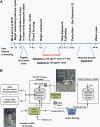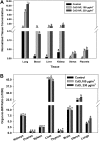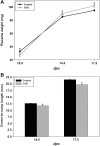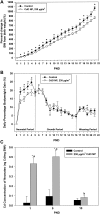Cadmium associated with inhaled cadmium oxide nanoparticles impacts fetal and neonatal development and growth
- PMID: 22240978
- PMCID: PMC3307609
- DOI: 10.1093/toxsci/kfs008
Cadmium associated with inhaled cadmium oxide nanoparticles impacts fetal and neonatal development and growth
Abstract
One industrially important metal oxide nanoparticle (NP) is cadmium oxide (CdO). A study was performed using timed-pregnant CD-1 mice to determine if Cd associated with inhaled CdO NP could reach the placenta and adversely affect the developing fetus and/or neonate. Pregnant mice were exposed by inhalation either every other day to 100 μg of freshly generated CdO/m(3) (exposure 1) or daily to 230 μg CdO/m(3) (exposure 2). In each exposure, mice were exposed to CdO NP or carrier gas (control) for 2.5 h from 4.5 days post coitus (dpc) through 16.5 dpc. At 17.5 dpc, fetuses and placentas from both exposures 1 and 2 were collected, measured, and weighed. A subgroup from the second exposure was allowed to give birth, and neonates were weighed daily until weaning. Cadmium in the uterus and placenta, as well as in other maternal organs, was elevated in NP-treated mice, but was undetectable in fetuses at 17.5 dpc. Daily inhalation of 230 μg CdO NP/m(3) decreased the incidence of pregnancy (i.e., no evidence of implantation) by 23%, delayed maternal weight gain, altered placental weight, and decreased fetal length, as well as delayed neonatal growth. This study demonstrates that inhalation of CdO NP during pregnancy adversely affects reproductive fecundity and alters fetal and postnatal growth of the developing offspring.
Figures





References
-
- Barański B. Effect of exposure of pregnant rats to cadmium on prenatal and postnatal development of the young. J. Hyg. Epidemiol. Microbiol. Immunol. 1984;29:253–262. - PubMed
-
- Barański B, Sitarek K. Effect of oral and inhalation exposure to cadmium on the oestrous cycle in rats. Toxicol. Lett. 1987;36:267–273. - PubMed
-
- Bush PG, Mayhew TM, Abramovich DR, Aggett PJ, Burke MD, Page KR. A quantitative study on the effects of maternal smoking on placental morphology and cadmium concentration. Placenta. 2000;21:247–256. - PubMed
Publication types
MeSH terms
Substances
Grants and funding
LinkOut - more resources
Full Text Sources
Medical
Miscellaneous

